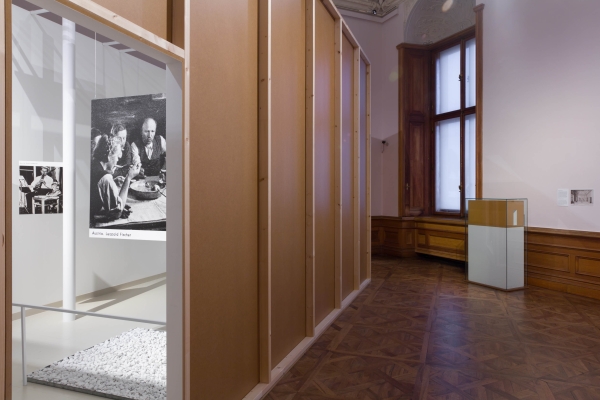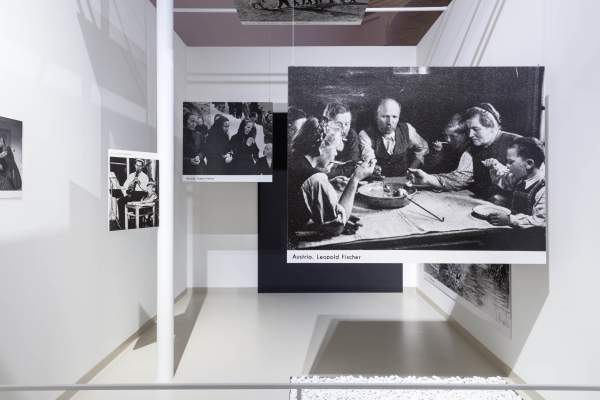
Installation view: from left to right: model 1:10, Family of Man, deconstructed, display window from walk-in model, 2018
Model 1:10, 1993
Family of Man, deconstructed, 2018
Installation view: walk-in model, model 1:10, 2018
Walk-in model, 2018
Walk- in model, quote by Edward Steichen, 2018
The Family of Austrians
Oberes Belvedere, Schausammlung Neu
Permanent installation since March 2018
Installation
Model (1:10) 73 x 43 x 160cm
Galerie Metropol, Vienna, Ronzoni room
seven b/w photographs, adhesive letters, fibreboard,
acrylic glass, pedestal
On permanent loan from Ernst Ploil
Walk-in model (1:1) 596,7 x 344,8 x 310cm Galerie Metropol, Vienna, Ronzoni room
seven enlarged b/w photographs, wire, adhesive letters,
metal tray with pebbles
Family of Man, deconstructed, 2018
Catalogue cover, collages from book pages, partly overpainted,
b/w photographs; facsimiles
Courtesy Christian Philipp Müller
Can images represent a nation? And what, in this context, would be typically Austrian? The installation The Family of Austrians by Christian Philipp Müller refers to probably the world’s most famous photo exhibition The Family of Man, which was shown in 1955 at the Museum of Modern Art in New York. It then toured to thirty-eight countries and was seen by over nine million people. For this show Edward Steichen amassed over five hundred photographs from sixty-eight countries. The aim was to demonstrate the universal nature of human experiences such as love, work, and leisure and how these transcend ethnic, social, and economic differences.
Müller selected the images that represent “Austria” from this pool, isolating them as a “family” in an arrangement that echoes the historical exhibition. These pictures from the 1950s depict folkloric, rustic motifs—Alpine-style parlors, going to church, traditional fairs—as if modernism had never happened here. Steichen’s universal image of humanity is exposed as a collection of antiquated stereotypes revealing a clash between how we see ourselves and how we are seen by others.
Christian Philipp Müller first exhibited the installation The Family of Austrians in 1993 at Galerie Metropol in Dorotheergasse in Vienna’s first district. He combined reproductions of the seven photographs from The Family of Man with a quote from Edward Steichen in a display that echoed the exhibition’s design at the MoMA. At the same time the artist made models of the gallery space on a scale of 1:10 indicating the endless potential combinations of the seven photographs and the quote. Every subsequent presentation of the installation alluded in a more or less abstract way to the original version—as here in the permanent displays at the Upper Belvedere. But the revealing message at the heart of The Family of Austrians is always preserved.
//
Können Bilder eine Nation repräsentieren? Und was wäre in diesem Zusammenhang typisch österreichisch? Die Installation The Family of Austrians von Christian Philipp Müller bezieht sich auf die weltweit wohl bekannteste Fotoausstellung The Family of Man, die 1955 im Museum of Modern Art in New York gezeigt und in der Folge in 38 Ländern von über neun Millionen Menschen gesehen wurde. Für diese Schau hatte Edward Steichen über 500 Fotografien aus 68 Ländern zusammengestellt, die die Universalität menschlicher Erfahrungen wie Liebe, Arbeit, Freizeit über ethnische, soziale und ökonomische Unterschiede hinweg belegen sollten.
Aus diesem Pool greift Müller jene Bilder heraus, die „Österreich“ repräsentieren, isoliert also eine „Familie“ in einem Arrangement, das das historische Ausstellungsdisplay zitiert. Die in den 1950er-Jahren angefertigten Aufnahmen zeigen folkloristisch-ländliche Motive zwischen Bauernstube, Kirchgang und Volksfest – ganz so als hätte die Moderne hier nicht stattgefunden. Steichens Universalbild des Menschen entlarvt sich als eine Ansammlung antiquierter Stereotype, die Eigenbild und Fremdbild aufeinanderprallen lässt.
Christian Philipp Müller stellte die Installation The Family of Austrians erstmals 1993 in der Galerie Metropol in der Dorotheergasse im ersten Wiener Gemeindebezirk aus. Er kombinierte Reproduktionen der sieben Fotografien aus The Family of Man mit einem Zitat Edward Steichens in einem Display, das an die Ausstellungsgestaltung im MoMA angelehnt war. Gleichzeitig fertigte der Künstler 1 : 10-Modelle des Galerieraums an, in denen er die unendliche Kombinierbarkeit der sieben Fotografien und des Zitats andeutete. Jede spätere Präsentation der Installation bezog sich mehr oder weniger abstrahiert auf die ursprüngliche Fassung – so nun auch jene hier in der Sammlungsaufstellung des Oberen Belvedere. Stets bleibt aber die entlarvende Aussage von The Family of Austrians erhalten.




